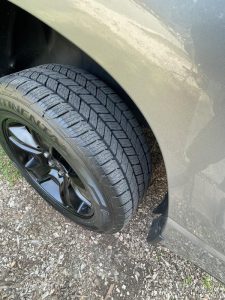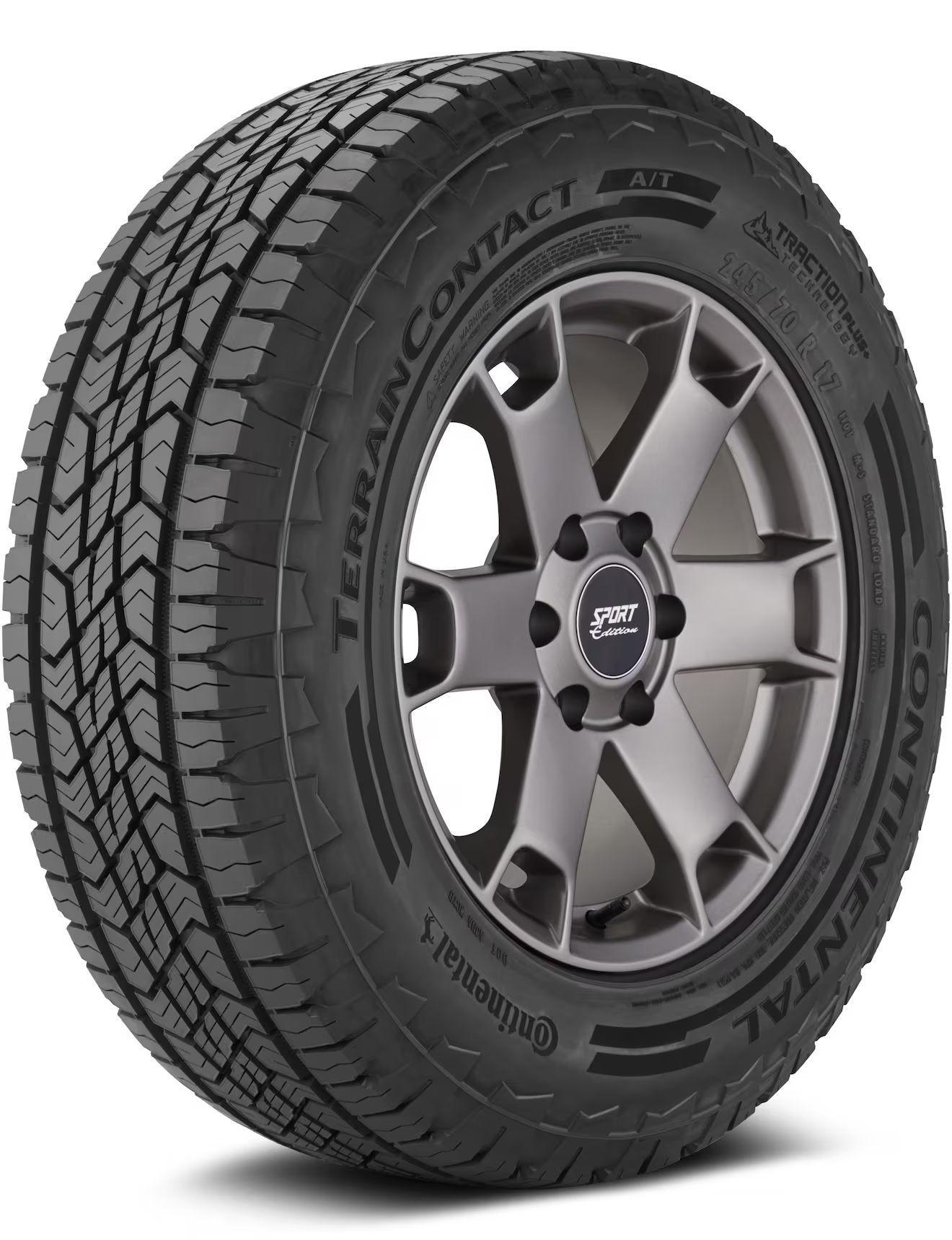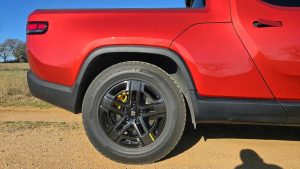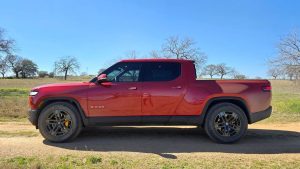Michelin Defender LTX M/S is a highway all-season tire that has a wide product range. This tire can be used on SUVs, commercial vans, sport utility vehicles, and any light truck. Due to its longevity and durability, it can be ever used on heavy-duty 3/4 ton or above pickups. Even though it’s an all-season tire, due to its high durability, it can even handle some off-road. Yet, knowing its limit is highly vital to get maximum performance from it. I pushed the limits a bit. Let’s dig into it and see what it’s capable of.
| Michelin Defender LTX M/S | |
|---|---|
| Best for | Longevity, cozy and quiet ride, heavy-duty light trucks, mostly highway-oriented commercial usage, mild off-road-like dirt & gravel |
| Category | Highway All-Season |
| Vehicle | SUV/Light Truck |
| Weight | 24 – 58 lbs |
| Made In | United States |
| Warranty (P-metric) | 70,000 Miles (50,000 for R-speed rate) |
| Available Sizes (Rim) | 15”, 16”, 17”, 18”, 19”, 20”, 22” |
| Labels | M+S |
As a former Bridgestone engineer, from my standpoint, Michelin Defender LTX M/S has unique traction on wet and dry surfaces. Moreover, its light snow capability is highly acceptable and it can handle icy surfaces as well. The long-lasting tread is its main feature. Furthermore, surprisingly, it can handle mild off-road very well. However, Michelin Defender LTX M/S has a bit stiff ride and makes some noise after half of its tread. Though worth reminding, its loose ground performance is limited to a couple of inches.
Table of Contents
Dry Performance
Traction, steering response, or cornering stability. No matter what feature are we talking about, Michelin Defender LTX M/S’s performance is unquestionable. In my point of view, its design is superior in its category.
For a better understanding, I’m going to separate dry performance from the above features and explain them one by one.
Dry Traction
Even though it’s a narrow tire, due to its exceedingly siped rubber, it can provide tons of traction on the dry ground.
Well, it’s obvious that Michelin put hauling and towing into consideration at the design stage of this tire. Its compound is stiff, though, its block-type shoulders and sectional ribs provide the necessary void area for a perfect traction ability.
Michelin Defender LTX M/S has an alpha plus dry traction capability.
Due to its narrow tread and robust center rib and shoulders, Michelin Defender LTX M/S provides an extremely quick steering response. Since the tire is available in high-profile sizes, its balance is overperforming most of its competitors.
Michelin Defender LTX M/S is a highly communitive tire. Well, that’s what it’s built for!
Cornering Stability
According to my research, the tire’s internal structure contains two reinforced steel belts. Well, when you combine it with a symmetrical pattern and reinforced sidewalls(they’re extremely stiff but flex perfectly under the heavy loads), the vehicle stands steel while cornering at high speeds.
Michelin Defender LTX M/S provides bellyful cornering stability. I strongly recommend it if you’re an inexperienced driver.
Unlike common knowledge, summer tires outperform all-season tires on wet pavement. In a word, all-season tires trade longevity with traction. Yet, Michelin Defender LTX M/S is an exception.
It is more accurate to evaluate wet pavement performance as high speed and low-speed performance. While low-speed performance is related to traction ability, high-speed performance hinges on hydroplaning resistance. Well, let’s evaluate them seperatly.
Wet Traction
Since all-season tires have a stiff compound, their traction capability is highly limited compared to summer tires. Therefore, manufacturers use exceedingly notched rubber to increase biting edges, herewith, traction.
At first blush, you might think Michelin Defender LTX M/S has a rib-type pattern. Well, theoretically, it’s true. Yet, these ribs are sectional, hence, this tire has a lug-type pattern.
While its lug-type pattern enables tons of biting edges, Michelin also increases the biting edges with 3D-Wave sipes.
As a result, Michelin Defender LTX M/S provides unique traction on wet pavement.
Note: While ribs have full-depth sipes, shoulder section sipes go through the half. Therefore, Michelin Defender LTX M/S’s shoulders wear evenly. So, uneven wearing isn’t an issue.
Hydroplaning Resistance
In the shortest, hydroplaning is the uncontrollable sliding on a wet surface. It’s caused by the water inside of the tread. When water fills the void area of the tire, if the tire has a low hydroplaning resistance, the tire loses contact with a surface, herewith, sliding occurs.
So, hydroplaning resistance is the water evacuation capability of the tire.
Due to its wide circumferential and lateral grooves and open shoulder slots, Michelin Defender LTX M/S has a huge hydroplaning resistance.
Winter Performance
As I’ve mentioned before, due to their stiff compounds, all-season tires lack traction. Therefore, they need notches. However, these notches generally aren’t enough to provide decent traction in winter conditions.
Well, Michelin Defender LTX M/S is an over-siped tire. Therefore, it’s a decent tire in winter. Though worth reminding, all-season tires can perform best above 7 Celcius degrees. Under this temperature, they get lost traction.
Michelin Defender LTX M/S isn’t marked with 3PMSF. That means it’s not capable to perform in severe winter conditions. Well, I don’t agree with them!
Light-Snow Traction
Light-snow traction is related to the same features as wet traction. Yet, a compound of the tire gets stiffer in winter conditions. So, traction capability decreases.
However, Michelin Defender LTX M/S is unusual. Michelin uses ‘Evergreen Compound’ for this tire. The most interesting feature of this compound is it doesn’t get too stiff in winter conditions. Well, I have to admit that, its light snow traction capability stays slightly behind compared to wet traction. Yet, this is an exceptional performance for a tire that doesn’t have a 3PMSF.
Michelin Defender LTX M/S has superior light snow traction. I strongly recommend it.
Deep Snow Traction
I haven’t tried this tire on deep snow. Yet, I read tons of positive comments about its deep snow traction. Well, in my point of view, it was not possible. So, I made deep research.
Since the tire can clean itself and have a relatively deep tread, it can handle deep snow. In that case, I still recommend taking it easy and limiting the snow depth to a maximum of 8 inches.
Here is a video for a better understanding.
Ice Traction
So, the tire has a bit stiff compound. However, its compact tread(less void area) bring some advantage. Since the ice performance needs compact tread, Michelin Defender LTX M/S is one of the best ice tires in its segment.
Though worth reminding, this segment has highly limited ice performance. Hence, it’s above average but not a perfect tire for ice.
You may watch the below video and see the slight sliding from time to time. Well, this amount of sliding is highly acceptable for me. The decision is yours.
Riding Comfort
The riding comfort of this tire may vary from user to user.
I have to admit that, the tire compound is stiff and its sidewalls are tough as hell. So, its ride seems stiff if you’re going to change from touring all-season tires.
For its segment, its riding quality is an alpha plus. Though worth reminding, these aren’t touring tires. If you compare its ride quality with touring tires, you’ll be disappointed.
I recommend Michelin Defender LTX M/S for light or heavy-duty work trucks and SUVs if you only do hauling or towing.
Note: Michelin Defender LTX M/S isn’t a touring tire. If the cozy ride is your priority, you may check this article out –> https://tireterrain.com/michelin-primacy-tour-a-s-review/
Road Noise
Due to its narrow tread and limited void area, Michelin Defender LTX M/S is a quiet tire at the beginning of its tread life. However, after half of its tread life, noise slightly increases. Well, this is caused by deep and wide sipes and it’s a bearable noise.
Michelin Defender LTX M/S is a quiet tire. Yet, it’s getting noisier when the weather gets cold.
Mileage
Tread life is where this tire shines.
Its strong advanced compound has an extremely high cut&chipping resistance. Hence, no matter how tough your surface is it doesn’t wear quickly.
Moreover, its symmetrical pattern design enables even wearing. So, if you follow the rotation time closely, I’m pretty sure that you can get 100,000 miles with this tire.
Getting maximum wear life from a tire is related to you as well as your tire,
If you’d like to learn how to get maximum tread life:
Warranty
Michelin implements two different warranties for this tire.
T&H Speed Rating: 6 years and 70,000 miles wear life warranty
R Speed rating: 6 years and 50,000 miles wear life warranty
Note: If your front and rear sizes are different, warranty mileage drops the half.
Manufacturer Special Warranty: 60 days of satisfaction and 3 years of free flat tire change assistance ( pay for the tire but change and towing are free)
For detailed information,
Michelin Warranty Brochure: https://www.tirerack.com/images/pdf/warranty/MI0619.pdf
Off-Road Performance
I guess people misunderstood the design goal of this tire. In fact, this tire doesn’t build for off-road. It’s capable for some off-road only for the working trucks. So, I can confidently say that if you’ll use this tire for rock crawling and damage the sidewall, the warranty will not cover your loss.
However, due to its strong sidewalls, it has the capability to handle mild off-road.
So, dirt and gravel are the only surfaces this tire performs perfectly.
Due to its open sloth shoulders and sectional ribs, it can handle dirt and gravel with ease. Moreover, its extremely strong sidewalls don’t take any damage from sharp rocks or something.
I strongly recommend Michelin Defender LTX M/S for mild, occasional off-road.
Sand
Even though it’s a narrow tire, due to its blocky pattern, it can handle sand. Well, at least, it doesn’t dig deep and stuck into the sand.
This isn’t a beach driving tire but it’ll handle occasional sand. This tire doesn’t design for air-down driving.
Mud
It can evacuate the mud but if only mud’s not too deep. This isn’t a tire for adventure.
Rock Crawling
Its tough sidewall might make you think it’s a good tire for rock crawling. Well, it’s right but for a very short time.
The tire heats up so quickly when using it at low PSI. So, you may fail the bead if you expend driving time.
I don’t recommend this tire for a rock crawling.
Sizes
| 15” | 16” | 17” | 18” | 19” | 20” | 22” |
|---|---|---|---|---|---|---|
| 205/65R15 99T XL BSW | 215/55R16 97H XL BSW | 215/50R17 95H XL BSW | 235/55R18 100T SL BSW | 235/45R19 95H SL BSW | 235/55R20 102H SL BSW | 275/50R22 111H SL BSW |
| 215/75R15 100T SL OWL | 215/70R16 100H SL BSW | 225/55R17 101H XL BSW | 235/60R18 107H XL BSW | 235/55R19 105H XL BSW | 245/60R20 107H SL BSW | 285/45R22 114H XL BSW |
| 235/75R15 109T XL OWL | LT 215/85R16 115/112R E BSW | 225/65R17 102H SL BSW | 235/65R18 106T SL BSW | 245/55R19 103H SL BSW | 255/50R20 109H XL BSW | 285/45R22 110H SL BSW |
| LT 31X10.50R15 109R C OWL | LT 225/75R16 115/112R E BSW | LT 225/75R17 116/113R E BSW | 245/60R18 105H SL BSW | 255/50R19 107H XL BSW | 255/55R20 110H XL BSW | 305/40R22 114H XL BSW |
| 235/70R16 109T XL OWL | 235/65R17 104T SL BSW | 255/55R18 109H XL BSW | 255/60R19 109H SL BSW | 265/50R20 107T SL BSW | ||
| 235/75R16 112T XL OWL | 235/70R17 109T XL BSW | 255/65R18 111T SL BSW | LT 265/60R20 121/118R E BSW | |||
| LT 235/85R16 120/116R E BSW | 235/75R17 109T SL BSW | LT 255/65R18 120/117R E BSW | 275/55R20 113T SL BSW | |||
| 245/70R16 107T SL OWL | 245/65R17 107T SL BSW | 265/60R18 110T SL BSW | 275/60R20 115T SL BSW | |||
| 245/75R16 111T SL BSW | LT 245/70R17 119/116R E BSW | 265/65R18 114T SL BSW | LT 275/65R20 126/123R E BSW | |||
| LT 245/75R16 120/116R E BSW | LT 245/75R17 121/118R E BSW | 265/70R18 116T SL BSW | 285/50R20 116H XL BSW | |||
| 255/65R16 109T SL OWL | 255/65R17 110T SL BSW | LT 265/70R18 124/121R E BSW | LT 285/60R20 125/122R E BSW | |||
| 255/70R16 111T SL OWL | 255/70R17 112T SL BSW | 275/60R18 113H SL BSW | LT 285/65R20 127/124R E BSW | |||
| 265/70R16 112T SL OWL | 265/65R17 112T SL BSW | 275/65R18 116T SL BSW | LT 295/60R20 126/123R E BSW | |||
| 265/75R16 116T SL OWL | 265/70R17 115T SL OWL | LT 275/65R18 123/120R E BSW | LT 295/65R20 129/126R E BSW | |||
| LT 265/75R16 123/120R E OWL | LT 265/70R17 121/118R E OWL | LT 275/70R18 125/122R E BSW | 305/50R20 116H SL BSW | |||
| 275/70R16 114H SL BSW | LT 285/70R17 121/118R E BSW | 285/60R18 120H XL BSW | LT 35X12.50R20 121R E BSW | |||
| LT 285/75R16 126/123R E BSW | LT 295/70R17 121/118R E BSW | LT 285/65R18 125/122R E BSW | ||||
| LT 295/70R18 129/126R E BSW |
Most tire sizes begin with modifier letters(P, LT, etc.) that identify the type of vehicle or type of service for which they were designed. Here is a perfect guide for reading tire size –> https://tireterrain.com/how-to-read-tire-size/
- If you’re an SUV owner and Michelin lover, I highly recommend checking the ‘Best Michelin Tires for SUV‘ out. You can find masterpiece suggestions that are classified by needs.
- If Michelin tires are too expensive for you, I highly recommend checking the ‘Michelin vs Bridgestone‘ out. You can find affordable options
Size Selection
Before we dive into selecting the right tire size, it’s essential to understand the tire standards that manufacturers follow.
Technical Standards & Regulations
In Europe, the tire standardizing organization is called ETRTO. In the United States, it’s The Tire and Rim Association (TRA), while in Japan, it’s the Japanese Automobile Tire Manufacturers Association (JATMA). Although there may be other organizations, they generally align with one of these three.
When it comes to passenger car tires, TRA designates them by placing the letter “P” in front of the size to indicate conformity to the TRA standard. On the other hand, ETRTO and JATMA do not use any letters, which can sometimes be confusing when determining which standard is being used.
For light truck tires, TRA uses the letters “LT” in front of the tire size, while JATMA places the letters “LT” after the size. ETRTO, however, uses the letter “C” after the size to indicate tires of this type.
In the realm of medium truck tires, ETRTO uses the letter “C” after the size to designate tires designed according to their standard. In contrast, TRA and JATMA do not use any letters in this context.
Now, here’s what’s essential: Tires with the same dimensions (size) may have different maximum load capacities depending on the standard being followed. So, it’s crucial to consider the relevant standard when choosing tires.
When it comes to load capacity designations, “SL” (Standard Load) and “XL” (Extra Load) are used for all passenger car tires, regardless of which standard is being followed. In the ETRTO standard, “Reinforced” is also used as an alternative to “XL.”
Load Range, on the other hand, is specific to TRA. ETRTO and JATMA use the term “Load Index.” While TRA references Load Indexes, it’s important to note that the values provided are approximate.
To sum it up, understanding the tire standards and designations is vital as they play a significant role in determining the right tire size and load capacity. By considering the appropriate standards, you can make an informed decision when selecting tires that meet your vehicle’s requirements.
Here are two great articles if you wanna dive deeper:
Load Range vs Load Index: https://www.discounttire.com/learn/load-range-load-index
Tire Sizing System: https://www.discounttire.com/learn/euro-vs-pmetric-tires
How to Select the Right Tire Size Based on Your Requirements?
When it comes to selecting tire sizes for your vehicle, it’s important to keep in mind that most vehicles offer more than one original equipment size. Let’s take the 2019 Ford F-150 Lariat Crew Cab 4WD as an example. You have three different tire size options: 275/55R20 SL, 275/65R18 Load Range C, or 275/65R18 SL.
Note: I use Toyo Open Country AT3 for an example tire. You can use this link to see tire options for your vehicle and then make a comparison between the sizes:
https://www.discounttire.com/fitment/vehicle
If you don’t know your tire size: https://tireterrain.com/find-tires-by-vin-number/
Let’s focus on comparing the 275/65R18 SL and 275/65R18 Load Range C options for a more detailed comparison. Your decision should be based on your priorities. If you prioritize a smooth ride and better handling, the SL option is the way to go. On the other hand, if you value hauling or towing performance and tire longevity, the Load Range C option would be a better fit.
As a tire engineer, my perspective often revolves around load-carrying capacity. Generally, tires with higher load capabilities tend to provide a stiffer ride. However, there’s a bit of an illusion to consider. When you compare the two tires in the same size, the SL-rated tire may initially appear to have a higher load capability. But here’s the catch: P metric tires, like the SL option, need to be derated by a factor of 1.1 when used on a truck. Crunching the numbers reveals that the SL option actually has a lower maximum load capability. Additionally, it boasts a lower tread depth, which translates to better responsiveness.
The same principles I mentioned earlier also apply when comparing XL and E Load range tires. In summary, if your vehicle allows for Passenger Car or LT (Light Truck) tires, going with a passenger option will provide you with better on-road manners. However, if you find yourself venturing off-road frequently, own a working truck, or regularly engage in towing and hauling heavy loads, then LT tires are generally the better choice for your needs.
Couple of tips for towing;
- Even though the load index of passenger car tires fits, when it comes to towing, sidewall stability is the issue. Hence, LT tires with Load Range C, D, or E provide better stability.
- Generally, a load index higher than 119 is recommended for towing
- Proper loading is important for even wearing. 60/40 rule should be followed. 60% of the weight should be on the front axle and 40%of weight should be applied rear axle of the trailer. Besides that, try to center load. Start with heavier ones if you gonna stack them up.
To wrap it up, selecting the right tires comes down to choosing the ones that align with your driving preferences and specific requirements.
Conclusion
Michelin Defender LTX M/S is one of the best tires in its segment. However, it’s a highway all-season tire. Hence, comparing it to touring or all-terrain tires isn’t fair. This tire is a good fit for those who need longevity, durability, and solid traction on every surface but the loose ground (deep snow, sand, mud).
| Michelin Defender LTX M/S | |
|---|---|
| Best for | Longevity, cozy and quiet ride, heavy-duty light trucks, mostly highway-oriented commercial usage, mild off-road-like dirt & gravel |
| Category | Highway All-Season |
| Vehicle | SUV/Light Truck |
| Weight | 24 – 58 lbs |
| Made In | United States |
| Warranty (P-metric) | 70,000 Miles (50,000 for R-speed rate) |
| Available Sizes (Rim) | 15”, 16”, 17”, 18”, 19”, 20”, 22” |
| Labels | M+S |
I hope the article was helpful. If you have any further questions, you can leave them below or reach out via e-mail. Have a safe ride folks!







